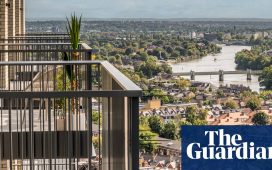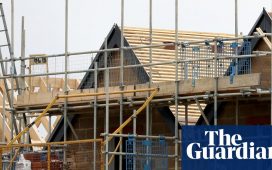By the time property developer Aby Rosen bought New York’s Seagram Building in 2000, both the mid-century Midtown tower and its namesake Canadian distiller were past their prime.
But the building was the making of Rosen’s real estate empire. Together with his longtime business partner Michael Fuchs, their company RFR Holding and a vast collection of modern art, Rosen renovated, rebranded and remarketed unloved landmarks at higher rents.
“Rosen brought an art collector’s eye to real estate,” said Bob Knakal, who heads brokerage firm BK Real Estate Advisors and has worked on deals for Rosen in the past. “He looked at buildings and saw things that other people missed.”
The 375 Park Avenue tower, never officially named the Seagram Building, was completed in 1958 as the first Manhattan skyscraper with floor to ceiling windows. At the start of its fifth decade, it was draughty and energy inefficient with a fire-prone electrical system and leaky fountains in its plaza. The building’s famed Four Seasons restaurant was in its twilight.
The German émigré bought the property for $375mn and spent tens of millions more on upgrades. Over the next decade, it was rarely anything other than full. By 2013, it was a $1.6bn testament to Rosen’s acuity at wringing fortunes from faded landmarks as well as his spot in the top tier of New York developers.
Now it only produces about half the income it did before the pandemic, and Moody’s Analytics last month included it on a list of properties that may be difficult to refinance. RFR refinanced a $400mn debt tied to the building in December, but still owes $750mn on a 2013-vintage loan.
Since 1991, Rosen has bought more than 50 buildings across Manhattan — including a half stake in the Chrysler Building. He has sold a few along the way, as well as diversified by buying buildings in Seattle, Tel Aviv and elsewhere.
But the flashy purchases of a man with an equally showy social life may now be starting to catch up with him.

Billions that Rosen has borrowed on the Seagram Building and other properties are either coming due in the next year or already have, at a time when higher interest rates and the post-Covid realities of office have cut commercial real estate valuations and made refinancing more difficult.
RFR said the Seagram Building was “fully leased with an investment grade tenancy” and that operating profits are set to more than double this year.
Even so, similar stress is being replicated across the RFR portfolio.
In 2018, Rosen told the Financial Times that the value of RFR’s portfolio had climbed to $14bn. Since then, the global real estate market has not been kind.
He has already been forced out of some of his marquee properties, including the Lever House, and a high profile office-to-condo project in Midtown Manhattan.
Last week, he had $470mn in debt come due on 285 Madison, a 26-storey building near New York’s Grand Central Station worth $610mn when he took out the loans in 2018. In 2022 it was valued at $60mn less than the debt.
RFR is far from the only New York developer feeling the pain from a post-Covid real estate downturn. Still, the developer and his partners have to reckon with at least $2.5bn in debt either coming due in the next year or already past due, a FT analysis of publicly available loan data shows.
The analysis found 16 loans connected to more than 20 properties that RFR owns, by itself or with partners. Collectively, those buildings generated just over $26mn last year after interest payments, nearly three-quarters less than the $97mn they were expected to when RFR and its partners took out the debt.
Twelve of the loans are in some state of distress, whether flagged by mortgage servicers as at risk of default, delinquent or still outstanding despite the maturity date having passed.
Four of the buildings are not bringing in enough rent to cover mortgage expenses. Another two are either empty or about to be: one of which being a Brooklyn office building that was fully occupied by WeWork before the bankrupt co-working company broke its lease last year.
Lawsuits and mortgage filings point to a growing pile of unpaid bills.
Earlier this month, a former top executive of Rosen’s RFR Holding sued Rosen and Fuchs for $20mn, alleging they had missed two deadlines this year on payments tied to a 2019 exit package.
A Blackstone venture is separately pursuing the developers for nearly $50mn, one of a number of outstanding loans that the private equity group and its partners bought from the failed bank Signature.
RFR has also missed mortgage payments and a property tax bill totalling just over $9mn on 522 Fifth Avenue. The building facing foreclosure is a Miami retail property Rosen’s group bought in 2019 for $20.5mn.
“Aby is at the top of the game in being astute, but even the people who were astute with their leverage are falling to these higher interest rates and being unable to refinance,” said Knakal at BK Real Estate Advisors.

With his other Midtown Manhattan landmark, the Chrysler Building, Rosen faces a distinct challenge. RFR co-owns the building with Signa, the insolvent Austrian property group founded by the one-time billionaire René Benko.
Signa’s administrator is now seeking to sell its half of the 77-storey art-deco skyscraper to raise cash. Although the building is 90 per cent let, the building comes with an expensive ground lease, limiting its attractiveness. A fire sale price could crystallise a depressed valuation — as well as leaving Rosen with a partner not of his choosing.
RFR declined to comment on the lawsuits, but said that the vast majority of its nearly 100 properties were “well leased and performing well”. The company was actively working to restructure the debt of those on its properties experiencing stress, it added.
“No one invested in real estate is immune to the pressures from fluctuating capital markets or the changing trends in work and lifestyle that we are currently seeing,” RFR said. “We’re confident in our ability to work through these obstacles as we have in the past.”
Rosen has also used unpaid bills as a negotiating tactic before. In a fight over the currently closed Gramercy Hotel, RFR stopped paying its lease in mid-2020, claiming the pandemic had made the property worthless.
But with $929bn in US commercial mortgage debt set to come due this year according to the Mortgage Bankers Association — about $180bn of which is tied to office properties — investors are watching not just to see what happens to Rosen, but what his challenges herald for the rest of the property industry.
“Any office owner is under significant pressure, so it is not a matter of if, but when maturities are coming up,” said an investor in distressed real estate loans.
“RFR has a lot of high-profile stuff needing to be refinanced right now, but there are a lot of developers all over the country with loans that are going to have to get worked out.”









